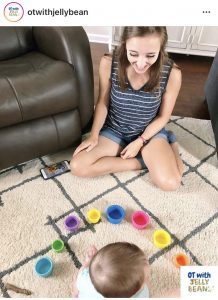When we moved into our new house almost three years ago, I was so excited for the space, the natural light, and the blessing of owning my own home for the first time. I am still incredibly grateful for those things, but it turns out that my favorite part of living in this house isn’t any of those things. It’s our neighbors. We’re surrounded by some of the kindest and warmest people I’ve ever met. One of those neighbors is Jesse Bowen and her husband, Britt. We met them pretty soon after they moved in and immediately started making jokes because their house is almost our house’s twin in color and floor plan. Jesse has become a good friend of mine, and I’m so blessed by the way she loves my kids. She also happens to be a pediatric occupational therapist and always has fun ideas for activities for my daughter. Before I met Jesse, I didn’t know that pediatric occupational therapy was a thing, so I asked her to participate in this interview in case you’d never heard of this type of professional either.
Tell us a little about yourself.
My name is Jesse Bowen, but my kiddos call me Jellybean. I have been in the Auburn Opelika area since 2011. I moved here for college, got my degree in child development, then attended OT school. I worked in Montgomery for almost 2 years and have been at the clinic here in Auburn for just over a year. My husband works for Auburn University, we live in Opelika, and have the cutest pupper around.

What is a pediatric occupational therapist?
If we think about occupations as things that OCCUPY your time, then we can break down what a pediatric OT does. A kid’s main jobs are to eat, dress, develop fine and gross motor skills, sleep, and play! I also specialize in sensory integration.
What sort of issues can a pediatric OT help with?
Areas where a child may have difficulty and need to see an OT are: attention span; postural control/balance (weak core); proximal stability (weakness in upper/lower extremities); fine motor skills; sensory processing and modulation; coordination/rhythm & timing; executive functioning; self-care; feeding; trunk rotation; motor planning; play; visual motor; social skills.
Frequently, the concerns that parents have during our initial evaluation are things like poor attention span, decreased functional play (i.e. dump and run), or extreme sensory aversions to hair brushing/teeth brushing/bathing/riding in the car/walking up the stairs/etc. Then, during the evaluation, I often observe the child to have decreased postural control (i.e. inability to hold their body up – they need to lean on one hand while seated, they w-sit, have difficulty sitting up in their chairs either at the dinner table or at school, etc.), as well as decreased sensory processing and modulation. OT can help with all of these areas. OT is such a wide range and can help with so much!
What are the most common issues/diagnoses you see?
Mostly developmental delays (basically, they just aren’t doing what they should be doing at that age), syndromes, autism, fine motor delays, aversions to everyday sensory inputs, and coordination issues. I have worked with babies (both in the NICU and as young as 4 months old in outpatient therapy) all the way up to 16 years old.
How do I know if my child needs help?
If your mama gut is telling you something is off, go with it! It’s important to remember when looking at milestones for your child’s age, that children develop at different speeds. While it’s okay if a child is a bit delayed in reaching a milestone, it’s never okay if a child SKIPS a milestone.
Do I need a referral from my child’s pediatrician to see you?
Yes. However, if you believe there are some issues and you think your child could benefit from OT, I am more than happy to email or talk on the phone and give some advice about what to bring up to your pediatrician for an appropriate referral.

What does a typical session entail?
An initial evaluation will consist of a motor test, sensory questionnaire, parent interview, and clinical observations. After that, a typical session is 30-45 minutes long. I am a play-based, child-led therapist. The first thing I ask kids when they come in is, “what do you want to play today?” I allow the child to choose what game, toy, or activity we play with to allow them some control. Then, I set up the game or activity in a way that encourages development of the child. I may set the activity up on a surface that elicits the child getting into tall kneeling or lying on their belly (i.e. tummy time) to build their core strength. I also set up activities to improve a child’s attention to tasks. A lot of my kiddos have poor attention spans. If the child chooses an activity that can be completed seated in less than 30 seconds, I add obstacles and create an obstacle course. For example, if a child chooses a puzzle, I’ll pull the puzzle pieces out of the board, place them on one side of the gym and then put a tunnel/crashpad/slide between the puzzle board and the puzzle pieces. To lengthen their attention span, I add more obstacles! If I’m doing my job right, all it looks like me and the child are doing is playing. However, the child is doing a lot of work – building their fine and gross motor strength, coordination, attention span, motor planning, body awareness, and so much more!
How long is a typical treatment plan?
Because my kids are a part of “habilitative therapy” as opposed to “rehabilitative”, we are in this together for the long haul. My evaluations are completed once a year and typically kids are in therapy for more than a year. These kids didn’t have skills and then experience a trauma that caused them to lose them; they never had the skills to begin with. We are doing hard work to gain new skills and further their neurological development.
What do you wish you could say to all parents? Either a piece of advice, caution, etc.
While it is my job to see the “delays” or “issues” in your child, I also take very good care to see your child’s strengths. I am not in this to “fix” your kiddo. I am here to help you and your child’s everyday life run more smoothly. Also, if your child does have a diagnosis, it is important to continue to hold your child to a standard. That standard may be different than other kids his or her age, however, it’s important to not let the diagnosis stand in the way of holding boundaries, requiring your child to take care of his/her space, helping out around the house, etc. You are still the parent, and while parenting this child may look a bit differently, OT can help you as a parent with what to expect of your child.
If you have questions about pediatric occupational therapy or think your child could benefit from an evaluation, feel free to follow and reach out to Jesse on her Instagram page @otwithjellybean, or call Auburn Therapy and Learning Center for more information.











